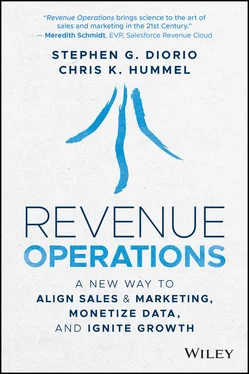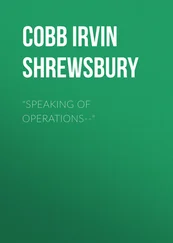Stephen Diorio - Revenue Operations
Здесь есть возможность читать онлайн «Stephen Diorio - Revenue Operations» — ознакомительный отрывок электронной книги совершенно бесплатно, а после прочтения отрывка купить полную версию. В некоторых случаях можно слушать аудио, скачать через торрент в формате fb2 и присутствует краткое содержание. Жанр: unrecognised, на английском языке. Описание произведения, (предисловие) а так же отзывы посетителей доступны на портале библиотеки ЛибКат.
- Название:Revenue Operations
- Автор:
- Жанр:
- Год:неизвестен
- ISBN:нет данных
- Рейтинг книги:3 / 5. Голосов: 1
-
Избранное:Добавить в избранное
- Отзывы:
-
Ваша оценка:
- 60
- 1
- 2
- 3
- 4
- 5
Revenue Operations: краткое содержание, описание и аннотация
Предлагаем к чтению аннотацию, описание, краткое содержание или предисловие (зависит от того, что написал сам автор книги «Revenue Operations»). Если вы не нашли необходимую информацию о книге — напишите в комментариях, мы постараемся отыскать её.
Revenue Operations: A New Way to Align Sales and Marketing, Monetize Data, and Ignite Growth
Revenue Operations
Revenue Operations
Revenue Operations — читать онлайн ознакомительный отрывок
Ниже представлен текст книги, разбитый по страницам. Система сохранения места последней прочитанной страницы, позволяет с удобством читать онлайн бесплатно книгу «Revenue Operations», без необходимости каждый раз заново искать на чём Вы остановились. Поставьте закладку, и сможете в любой момент перейти на страницу, на которой закончили чтение.
Интервал:
Закладка:
Service: Progressive Emergence
In the context we use for this book, service drives the customer's consumption of your product or service. This function covers activities like onboarding, activation, implementation, support, adoption, change orders, upgrades, maintenance, and many more. In most cases, these responsibilities are distributed across multiple organizations with many labels such as customer care or field service. Occasionally, the role is so important that a company will bundle many of these responsibilities into a branded, differentiated service offering like Apple's Genius Bar and BestBuy's Geek Squad.
“Service” isn't really one function but rather an amalgamation of roles from a variety of other organizations. This minimizes the institutional authority of service, even though the product consumption experience has become one of the most important factors in growing lifetime customer value. Cloud software companies do often have a function called “Customer Success” that handles much of the adoption process for complex offerings, and this function is starting to pop up in other industries that have complex implementation requirements.
The role of service has been elevated as it now commands a rising share of the customer interactions in the business, play a bigger role in revenue growth and relationship expansion, and have more direct control over the primary objectives of the business: namely, growing customer relations' lifetime value and net recurring revenue.
The “service” function doesn't exist as one entity. The product consumption experience is rarely managed inside one internal organization but is rather fragmented across regional, product, sales, marketing, and other teams with little rhyme or reason.
Service rarely has a seat at the executive table. Since service usually doesn't exist as a single organizational entity, it lacks institutional authority as a “constituency” and feels the absence of a c-level leader to advocate for and allocate resources to improving the customer ownership experience.
Driving product adoption has become more important to revenue expansion. Customer loyalty is critical to revenue expansion. First, customers are more focused on time to value and want faster returns on their assets and investments, so they buy in smaller, bite-size, iterative chunks. Second, subscription models also simplify the customer's ability to cancel the service, so the selling of value never stops.
Subscription business models are becoming the norm. Subscription models where the customer pays a scheduled usage fee per agreed-on period have become very popular. Such annuity revenue streams are very attractive and have penetrated many sectors as either rental- or performance-based fee models. How to transform one's portfolio into a subscription model is one of the core questions we hear from many companies.
The customer success function is moving beyond software as a service (SaaS) companies as people recognize its value add. Cloud companies natively understand the value of the customer ownership experience and have been pioneers in setting up “customer success” teams that manage the onboarding, activation, and training of new customers. That concept of a customer success function has migrated into many other industrial and technology businesses as a best practice.
Service leaders come from many different backgrounds – often project management – and hold many different titles. Yet the access to customer intelligence in this “function” rivals and maybe even beats marketing's data sets. This is a new, emerging space on the org chart that is worth watching.
The three teams work hard and do their best, but somehow things just aren't clicking.
Stepping back into the CEO shoes, there are common observations from all the functions.
Change is everywhere: Not only does change scare people, but it raises questions about whether the benefits of transformation are worth the pain.
Real-world problems are interdependent and interdisciplinary: Regardless of what its org chart looks like, any business needs to manage the entire revenue cycle as an integrated whole before, during, and after the transaction.
A systems-based approach is required: Consistency, repeatability, and automation help ensure that good performance is sustainable over time and scalable.
About Our Research
This book combines primary and proprietary research, a deep analysis of existing academic and corporate material in the field, consultations with world-class experts and thought leaders, and finally our own decades of personal experience as practitioners and analysts in the business world. As only teaming up an authority on go-to-market transformation and an operational executive can do, we argued over big-picture and minute details. In the end, we both agreed on what the real issue is and what needed to be done.
The foundation of the book is our primary research. This includes thousands of surveys with executives, managers, and performance professionals who manage growth in large and small businesses across many industries. When we reference our surveys, we will cite the actual survey and source document in a citation.
We also conducted in-depth interviews with over 110 growth leaders. These generally included the most senior executive responsible for growth in the business. In many cases it was the President, CEO, or Chief Operating Officer because that was the only individual who managed all the growth functions – marketing, sales, and service. In other cases, we met with executives that had been given an expanded remit to align revenue teams and resources around the customer. These executives had titles like Chief Growth Officer and Chief Revenue Officer. In some other cases we interviewed the functional leaders of marketing, sales, and services. Sometimes these executives insisted on being interviewed together because they regarded themselves as a team, not a manager. We will reference these interviews in statistics and direct quotes and will use the material for case studies about their challenges, best practices, and accomplishments.
In addition to this primary research, we made an exhaustive analysis of academic research and commercial research on the subject, which are also cited in the text. Our team comprehensively analyzed the most meaningful and relevant academic and commercial research on the science of growth. Here we were lucky enough to have the support of the leaders of the Marketing Sciences Institute, The Marketing Accountability Standards Board, The Sales Management Association, Analytics@Wharton, the Association of National Advertisers (ANA), and many associations and partners. These studies and academic papers are cited directly with links to the complete research reports and publications provided in the citations at the end of the book.
Finally, this research initiative drew heavily on the experiences and expertise of the world-class practitioners, academics, and experts of the Revenue Enablement Institute. These world-class experts include sales and marketing executives like Jeff McKittrick, Michael Smith, Greg Munster, Bruce Rogers, and David Edelman. They also include leading academics like Professor David Reibstein and Raghu Iyengar from the Wharton School of Business. We also were able to tap into decades of experience from experts in the science of growth including Cam Tipping, Bob Kelly, Corey Torrence, Bruce Rogers, Michael Smith, Doug Laney, and Howard Brown. All of these experts are quoted directly in the body of the book.
Our analysis of the commercial technology ecosystem was based on a comprehensive analysis of over 4,000 technologies that support sales and marketing over the past 18 months. Using the Revenue Operating System that you'll learn about in the book as a filter, we arrived at an initial list of the top 100 that we believe are transforming the commercial model and enabling the emergence of Revenue Operations, a system for growth. While this list is dynamic and will evolve over time, these initial 100 innovators are mentioned in context in the body of the book, and a full list is available on a website and research report listed in the citations.
Читать дальшеИнтервал:
Закладка:
Похожие книги на «Revenue Operations»
Представляем Вашему вниманию похожие книги на «Revenue Operations» списком для выбора. Мы отобрали схожую по названию и смыслу литературу в надежде предоставить читателям больше вариантов отыскать новые, интересные, ещё непрочитанные произведения.
Обсуждение, отзывы о книге «Revenue Operations» и просто собственные мнения читателей. Оставьте ваши комментарии, напишите, что Вы думаете о произведении, его смысле или главных героях. Укажите что конкретно понравилось, а что нет, и почему Вы так считаете.











